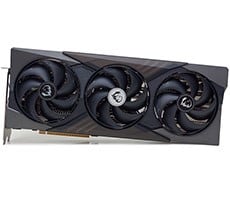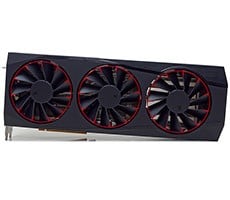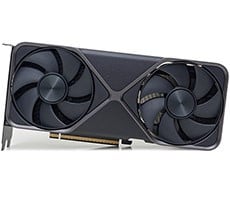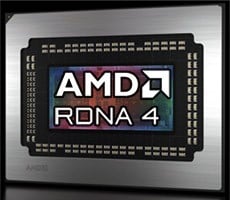MSI GeForce RTX 5070 Gaming Trio Review: Boosted Mid-Range Blackwell
We also spent some time overclocking the MSI GeForce RTX 5070 Gaming Trio to wring out some additional performance from its GB205 GPU and GDDR7 memory. We had great success overclocking with the RTX 5080, RTX 5070 Ti, and NVIDIA's GeForce RTX 5070 Founders Edition (which is based on the same GPU), and were eager to see what this beefier MSI card could do.
Overclocking The MSI GeForce RTX 5070 Gaming Trio
As we've already mentioned in numerous articles at this point, Blackwell-based GeForce RTX 50 series cards feature GPU Boost, which scales frequencies and voltages, power and temperatures permitting, based on the GPU's workload at the time -- just like the last couple of generations. Should a temperature or power limit be reached, GPU Boost will drop down to the previous boost frequency and voltage stepping, in an attempt to bring power and temperatures down gradually and not cause any significant performance swings.
To overclock the cards, the maximum boost clock and power limit can be tweaked to increase performance. Altering the fan speed curve and GPU voltage (when applicable) can allow for further tuning when supported.

MSI GeForce RTX 5070 Gaming Trio Hardware Monitor - Default "Stock" Settings
Like previous-gen cards, the MSI GeForce RTX 5070 Gaming Trio is usually voltage or power limited to prevent damage and ensure longevity, and it's those limits that will usually determine your success when overclocking. You can actually see the card his some of those limits in its stock configuration above.
Should you want to attemp to overclock it, the MSI GeForce RTX 5070 Gaming Trio's power target can be increased by up to 12%, but the GPU voltage can't be altered, at least not in the latest beta version of MSI's Afterburner currently available. That said, we were able to increase the GPU and memory clocks quite a bit over their default values, in addition to cranking up that power limit.
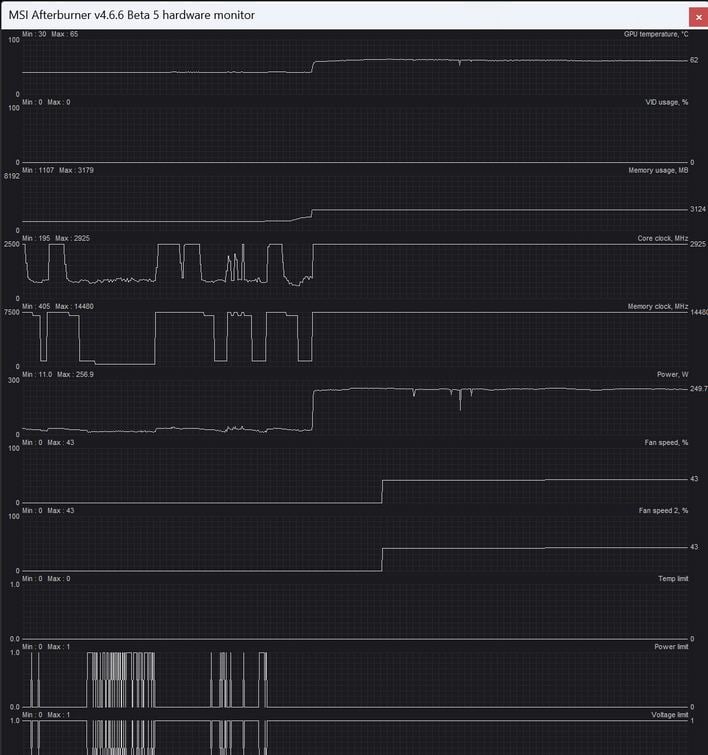
MSI GeForce RTX 5070 Gaming Trio Hardware Monitor - Overclocked
We upped the power target to its maximum (112%) and used the GPU and memory frequency offsets in Afterburner to manually alter theMSI GeForce RTX 5070 Gaming Trio's frequencies. We increased the GPU and memory clock offsets incrementally until the test system was no longer stable, showed on-screen artifacts, or performance peaked due to hitting a power or other limit.
When running with stock settings, the MSI GeForce RTX 5070 Gaming Trio hit a 2,595MHz boost clock and peaked at only 60°C, while maintaining its 28Gbps memory data rate (effective 14,000MHz). While overclocked, however, we were able to take its GPU clock all the way up to 2,925MHz with nearly a 29Gbps memory speed. That's nearly a 13% increase in GPU frequency for those keeping score.
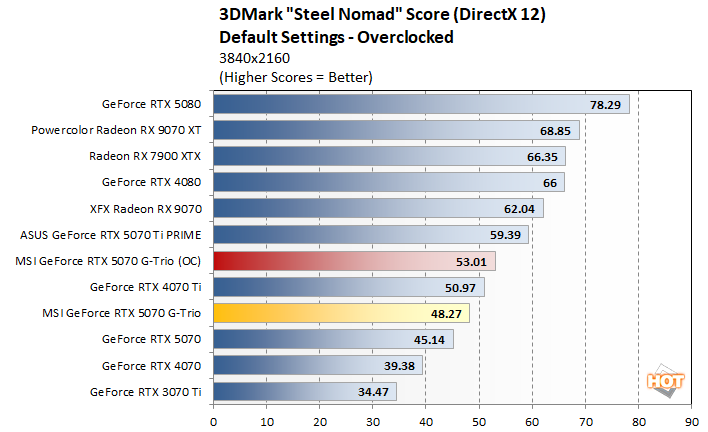
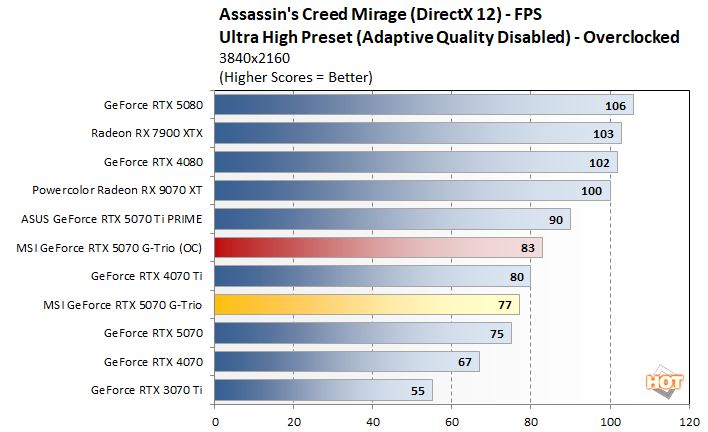
With the MSI GeForce RTX 5070 Gaming Trio overclocked, we re-ran some tests and saw some really nice performance gains, in the neighborhood of 8% - 10%. Just like some of the other cards in the RTX 50 series, it appears NVIDIA is being conservative with the RTX 5070's recommended clocks and power limit.
We should also mention, that while overclocked the MSI GeForce RTX 5070 Gaming Trio remained relatively cool. We saw temperatures peak at only 62°C, which was only a couple of degrees higher than stock and the fan speed maxed out at only 43%.
Total System Power Consumption
Throughout all of our benchmarking and testing, we also monitored noise output and tracked how much power the GPUs were consuming in our test system. Our goal here is to give you an idea as to how much power each GPU used while idle and also while under a heavy workload.
The MSI GeForce RTX 5070 Gaming Trios power consumption wasn't much different than NVIDIA's Founders Edition card. Comensurate with its higher clocks and additional fan, the MSI GeForce RTX 5070 Gaming Trio consumed only slightly more power than NVIDIA's card, which is to say it was relatively power friendly, especially in light of AMD's higher-end Radeons.
Noise is non-issue for the MSI GeForce RTX 5070 Gaming Trio as well. At idle or when under light loads, the card is effectively silent. It's fans spin down completely when the GPU temperature is low and don't ramp up until temps surpass 55°C. The card is dead silent at idle or under low loads. When under a heavy, sustained workload, the MSI GeForce RTX 5070 Gaming Trio's fans do spin up, but we would not consider it loud by any means. It is audible, but very quiet overall.MSI GeForce RTX 5070 Gaming Trio Review Summary & Conclusions
At this point, the launch of third-party GeForce RTX 5070 partner boards was probably a known quantity to many of you. This is the final launch in the first wave of GeForce RTX 50 series desktop GPUs (mobile parts are still inbound), and we’ve already evaluated NVIDIA’s GeForce RTX 5070 Founders Edition. The MSI GeForce RTX 5070 Gaming Trio takes everything from NVIDIA’s reference design and scales it up, with a bigger board, a bigger triple-fan cooler, and higher out-of-box clocks.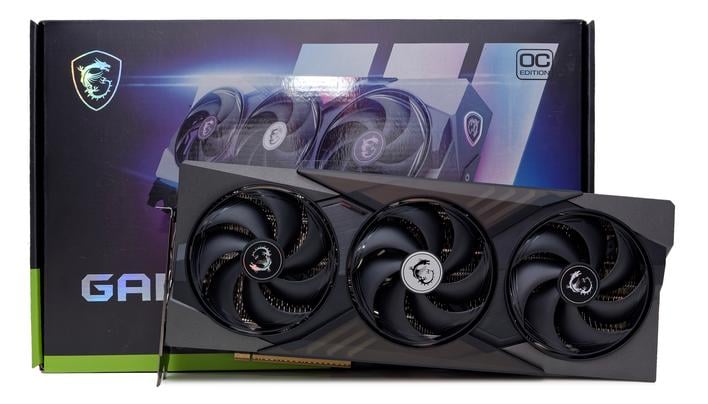
Focusing on the MSI GeForce RTX 5070 on its own for a moment, the card is solid. Its cooler is quiet and highly-capable and there’s plenty of headroom left under the hood for tweaking and tuning. There’s lots to consider in the GeForce RTX 5070’s price bracket though, especially with AMD’s RDNA 4-based Radeon RX 9070s now available. Hot clocked, RTX 5070 partner boards are currently priced well north of NVIDIA’s $549 MSRP. If you’re shopping in this price range, it behooves you to check out some of the alternatives at this time, and then weigh your options carefully.

